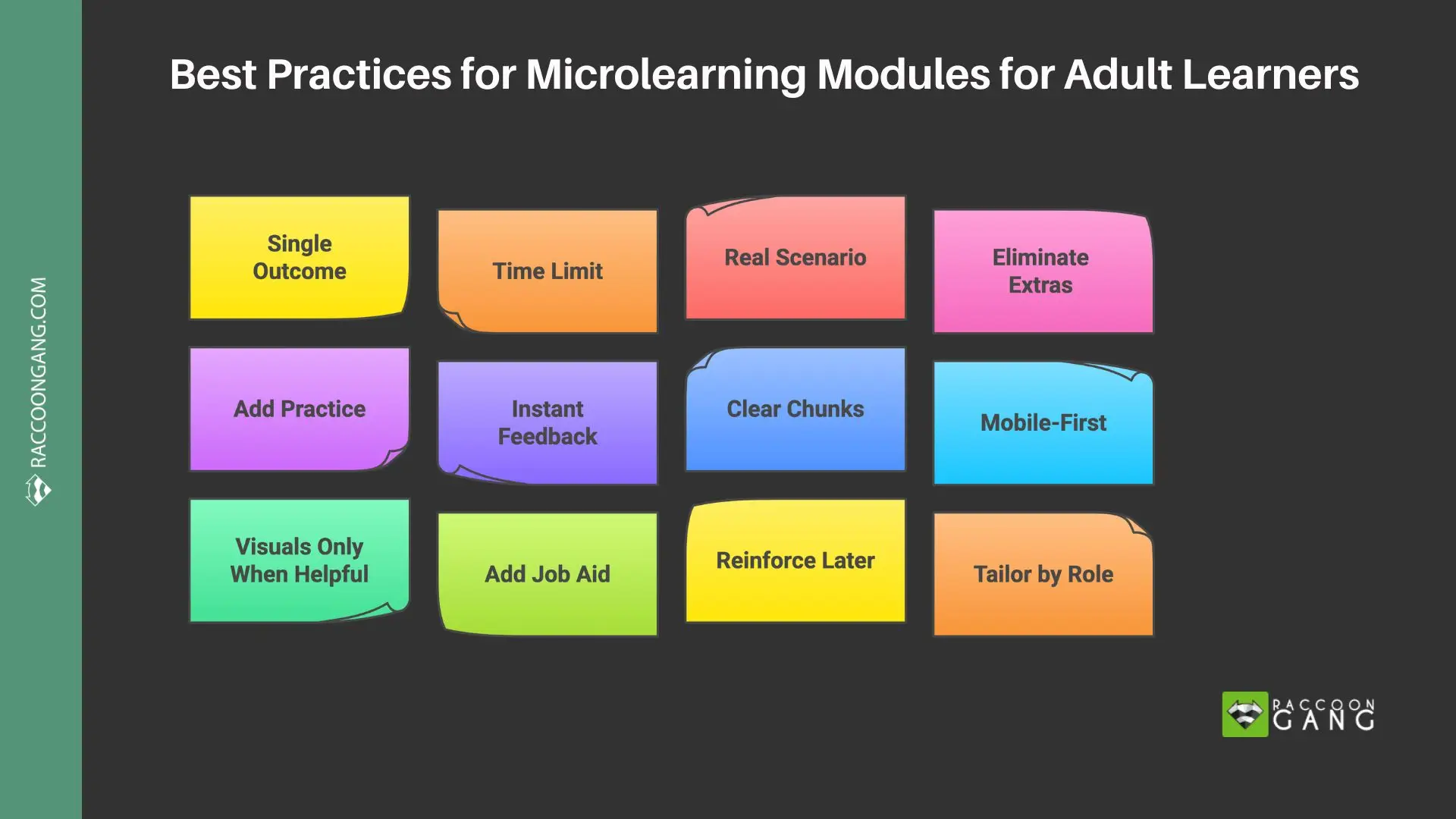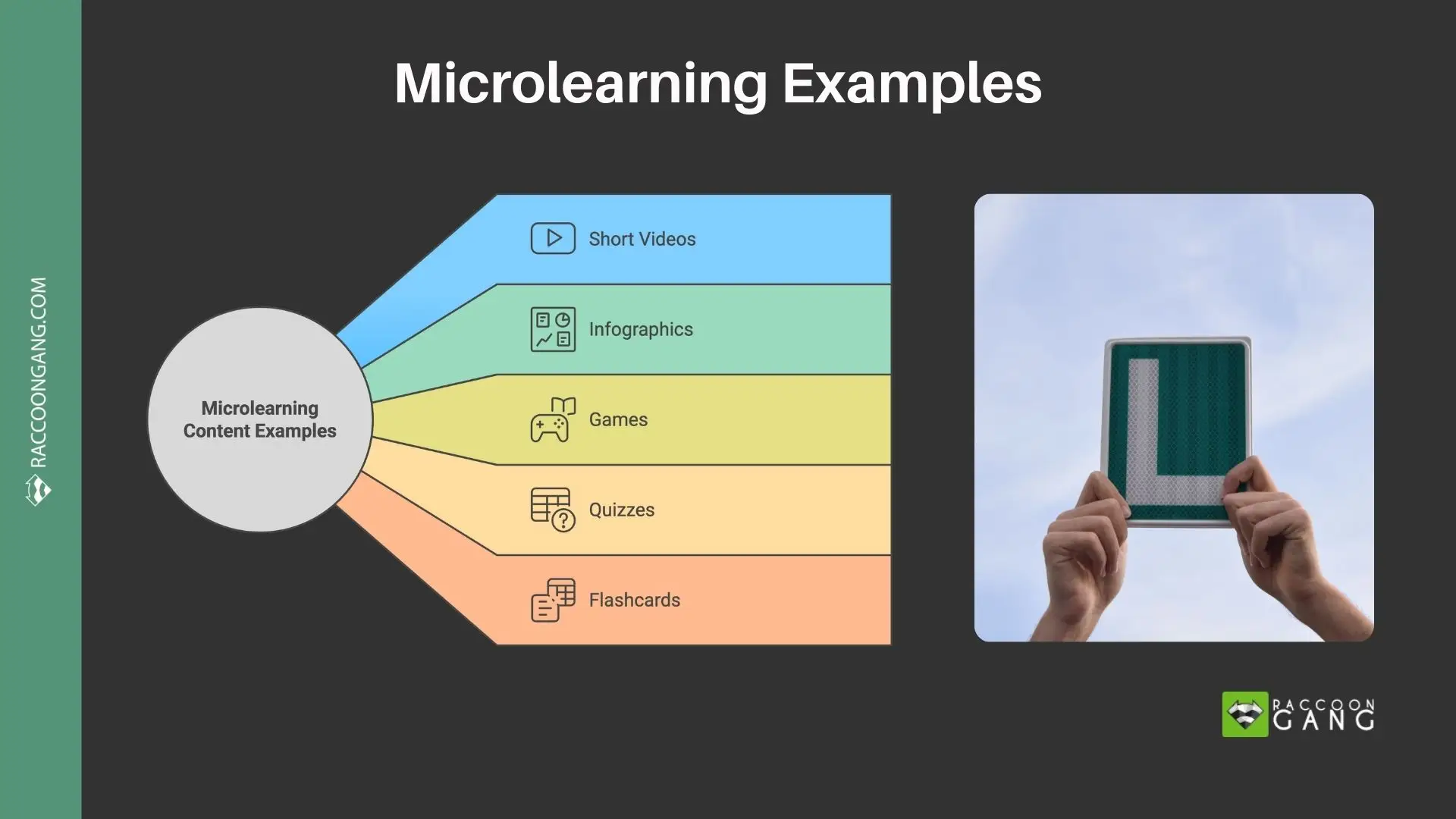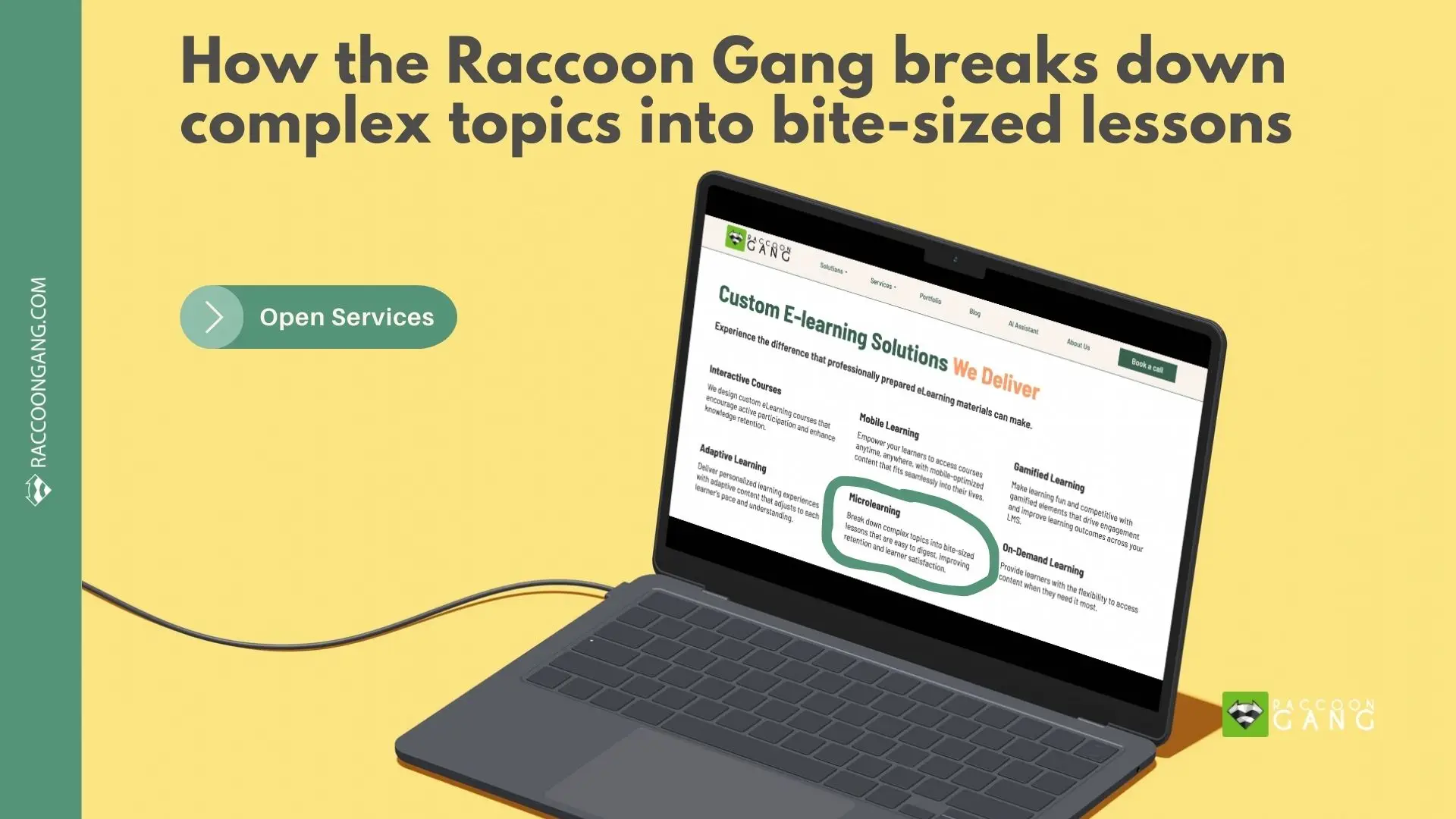The best Microlearning examples can start benefiting your organization tomorrow. You just need to choose the most relevant option for your case. Are you planning another compliance training? Do you need to run an internal course on information security? Are you preparing to launch an updated onboarding program?
Microlearning in business, like microlearning in education, helps learners beat the time crunch, so let’s look at the top ways to design short, focused lessons that keep learning moving without derailing the day.
What is Microlearning?
The concept of microlearning is relatively new. The base of this form of learning lies in essentially micro-dosing huge amounts of content. Instead of consuming huge chunks of content at one time, it is broken down into bite-sized pieces.
For example, typical classroom-style learning requires attending full-day training sessions to learn basic business concepts. With microlearning, the content is broken down into infographics or videos that explain the same concept within a fraction of that time.
This allows people to learn detailed concepts in the shortest amount of time without losing their productivity. Since the material is concentrated, it is easy to understand and retain.
Along with that, this style of learning allows people to begin applying the newly-gained skill right away. Instead of waiting hours or days to get irrelevant information, they have the necessary information required to apply what they learn.
With that, they are able to master the skill much quicker and at their own pace and comfort. This is what makes microlearning even more effective.
Microlearning Content Examples
When it comes to microlearning, content is not distributed in a typical manner. Here are some microlearning content examples:
Short Videos
Videos are a great way to explain processes and concepts within a few minutes. You can include infographics, animations, and other visual aids. This is especially beneficial for explaining concepts that can’t be explained in classroom settings.
Videos are one of the most used forms of microlearning content because they appeal to both auditory and visual learners. They also meet the needs of various audiences.
People can rewind and watch as many times as they want or come back to it if they ever feel the need to.
The key is to make the videos short. There is no point of having an hour-long video of somebody standing in front of a whiteboard.
Infographics
Infographics refer to static visuals that consist of condensed, complex ideas explained with text and graphics. They usually consist of facts, statistics, concise bullets, trends, etc., that represent the key information.
For instance, an infographic on road safety will consist of accident statistics, bullet points of the benefits of road safety, and a few tips, all in one image.
Games and Quizzes
This example of game-based microlearning is best suited for kinesthetic learners with short attention spans. They are engaging and require a high level of interactivity. They are also fun and immersive.
Instead of dry examinations, work-related challenges can be made into games or quizzes. They also allow you to integrate spaced repetition. This way, the key concept is reinforced in different forms in a short amount of time.
Animations
Whiteboard animations have become quite popular. You can find a number of YouTube videos that explain difficult concepts in short animations that resemble hand-drawn illustrations.
A common theme in these videos is storytelling. Combined with audio, these animations make use of visual guides to explain the concept as if they were telling a story.
Simulations
Used in the army, medicine, and various technical fields, simulations are regarded as one of the most effective ways of learning. They allow learners to face the challenge without the consequences or responsibility of failing.
Short simulations recreate a learner’s on-the-job environment. This way, they learn through experience. They can also redo the simulation as many times as they want to get a handle on the concept.

A quick checklist for building microlearning modules adults will finish: one outcome, real scenarios, fast practice, and reinforcement.
Microlearning Examples
Here are some microlearning examples that make use of different content distribution methods to encourage microlearning:
1. Business Courses
There is no shortage of applications and other programs that target organizational learning. The goal is to teach business courses or individual concepts without requiring too much of their time.
Salesforce Trailhead
Trailhead is a learning platform built for people who need answers fast and prefer one place for training and support. It pulls learning resources and community help into a single hub, which helps teams break down silos and keep momentum.
The platform serves everyone who works with Salesforce. Admins, developers, sales leaders, and end users can pick modules that match their role and goals. You can build technical skills, business skills, and soft skills as you move through your Salesforce journey.
This also supports a more level playing field. Large companies with big training budgets and smaller teams where people wear many hats can learn on the same platform, at the same pace, with the same access to guidance.
Intertek Alchemy
Intertek Alchemy is a workforce training platform built for frontline teams in manufacturing. Platforms like this can combine courseware with a web-based learning system.
For on-the-floor use, Intertek Alchemy offers a mobile app with tools like Coach and Playbook, which support short, task-focused learning where the work happens. It’s a practical fit for microlearning-style training on the production floor.
Highbrow
Highbrow is another business-related program that teaches business owners and related professionals about finances, business management, business fundamentals, cryptocurrency, etc. Each course is based on a 5-10 minute engaging video explaining the concept.
Creators moderate the courses and include information they see fit. This allows companies to create targeted courses that their employees can learn through the platform. This is one of the most effective microlearning examples for business professionals.
Cornerstone (Grovo) microlearning library
Grovo (now part of Cornerstone OnDemand) is a corporate learning platform. The platform is built for bite-sized microlearning.
The Grovo platform pairs an on-demand content library with tools to create and customize lessons. Grovo content has also been offered through Cornerstone’s content subscriptions.
2. Academic Applications
While the previous section explained some examples of microlearning in a workplace scenario, the following are examples of academic applications:
MCAT Self Prep
Getting into a medical school anywhere in the world is one of the toughest tasks. Applicants need to prepare for months to take the test. Back in the day, students used to buy expensive books and sit in the library for hours on end to prepare.
Now, applications like MCAT Self Prep use the concepts of microlearning to make information digestible and easy to retain. Currently, it is one of the only MCAT preparatory classes available online for free.
It delivers content through email as well. People who sign up get a question of the day. These questions come with short videos that explain the concept in its entirety. You can also make flashcards, take quizzes, and create your own study plans to customize your course.
Duolingo
Duolingo is currently one of the most popular language-learning platforms available in the market. You can access it on the desktop or through an application on a mobile device and learn a language of your choosing from a long list.
The application teaches the language through language games and quizzes. It consists of audio, visual, and kinesthetic content to allow all kinds of learners to grasp the language.
Each language course is divided into multiple sections with an increasing level of difficulty. There are daily goals assigned, which remind you to take a quiz each day. The games are short and engaging, allowing learners to enjoy the course. Additionally, the repetition of the words allows for building good language recall. This makes Duolingo one of the best microlearning examples for language acquisition.
Word of the Day
Word of the day is also another language learning application. Instead of teaching a variety of other languages, this application focuses on helping learners improve their English language skills.
As the name of the application suggests, learners use flashcard technology to memorize and understand a new word each day. Along with the meaning, the application also suggests how the word can be used.
Learners can even go back and test themselves on their vocabulary on the words that they learned previously.
Four Minute Books
With platforms like Audible, audiobooks have now become easily accessible. People can sign up and choose from a variety of titles and listen at their own pace, whenever and wherever they want.
Four Minute Books takes that concept and makes it appropriate for the principles of microlearning. As the name implies, the applications take books and boil down the main concept into bite-sized pieces.
This way, the learner can understand three key concepts explained in the books within four minutes without having to read the entire length of the book. This is a perfect microlearning example for those who want to gain knowledge quickly.
Khan Academy
Khan Academy practice sets break topics into bite-sized exercises with hints.
Quizlet
Quizlet’s “Long-Term” mode uses spaced repetition to support recall over time.
These two options (Quizlet, Khan Academy) also nicely illustrate how microlearning can be integrated into an academic environment.
How Some Companies Are Using Microlearning
Google’s Whisper Courses
Google makes use of email to deliver small doses of suggestions that the managers and/or employees can use in specific settings.
Each email explains the concept in a few sentences and then gives some example suggestions. This works because the email’s learning objective is to give reminders and a simple CTA (Call to Action) to the employees.
IBM’s Cloud Expertise Program
IBM is a world-renowned technology company. Being in the industry it is in, the employees need constant training and development to keep up with newer technologies and quickly.
In these situations, classroom training is not a viable option. It reduces productivity, wastes time, and doesn’t produce as many effective results as it could.
To solve this problem, IBM created IBM Micro Learning. This platform allowed its employees to get acquainted with cloud technology and gain expertise at their own pace.
The platform has a number of exercises that allow the employees to answer specific questions and develop skills. The employees found the content easily accessible and it helped them learn during the workday.
Raccoon Gang
Raccoon Gang uses a microlearning approach to design bite-sized lessons tailored for customers such as NASA and EBRD.
Final Thoughts
These examples of applications, platforms, and various companies making use of microlearning are proof that it works. In fact, it proves that microlearning as an integral part of online learning solutions can become the gateway to improved performance and productivity with high-impact learning.
Whether in a workspace or academic landscapes, it has the potential to simplify the learning process, allowing people to become better and more flexible learners.
FAQ
What makes a microlearning example ‘best’ for an enterprise?
The best example solves a real job problem. Typical characteristics include a short duration (3–7 minutes), practice or a quick knowledge check, and easy tracking.
Which formats work across roles?
It depends on the role, but microlearning often works well with short videos, quizzes, scenario questions, checklists, and flashcards.
How does microlearning fit in education?
You can use it for practice and recall. Add hints and fast feedback. Repeat with spaced reviews. Keep each unit focused on one skill.
How do we start a pilot?
We recommend picking one team and one goal. It would be a great start for the test. Next, build 5–10 micro-lessons. After it, you can run a test for 2–4 weeks. Don’t forget to measure completion and on-the-job use. Scale what works.







